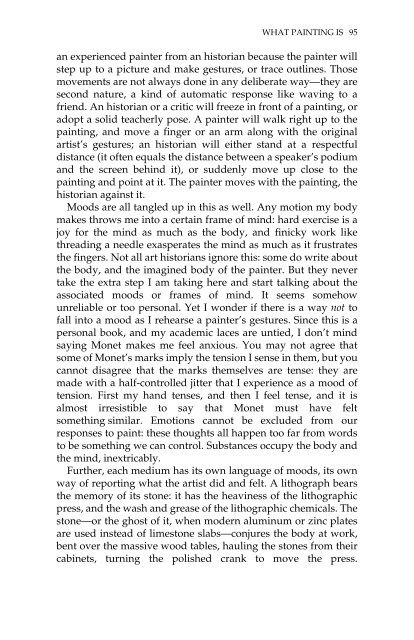What Painting Is: How to Think about Oil Painting ... - Victoria Vesna
What Painting Is: How to Think about Oil Painting ... - Victoria Vesna
What Painting Is: How to Think about Oil Painting ... - Victoria Vesna
Create successful ePaper yourself
Turn your PDF publications into a flip-book with our unique Google optimized e-Paper software.
WHAT PAINTING IS 95<br />
an experienced painter from an his<strong>to</strong>rian because the painter will<br />
step up <strong>to</strong> a picture and make gestures, or trace outlines. Those<br />
movements are not always done in any deliberate way—they are<br />
second nature, a kind of au<strong>to</strong>matic response like waving <strong>to</strong> a<br />
friend. An his<strong>to</strong>rian or a critic will freeze in front of a painting, or<br />
adopt a solid teacherly pose. A painter will walk right up <strong>to</strong> the<br />
painting, and move a finger or an arm along with the original<br />
artist’s gestures; an his<strong>to</strong>rian will either stand at a respectful<br />
distance (it often equals the distance between a speaker’s podium<br />
and the screen behind it), or suddenly move up close <strong>to</strong> the<br />
painting and point at it. The painter moves with the painting, the<br />
his<strong>to</strong>rian against it.<br />
Moods are all tangled up in this as well. Any motion my body<br />
makes throws me in<strong>to</strong> a certain frame of mind: hard exercise is a<br />
joy for the mind as much as the body, and finicky work like<br />
threading a needle exasperates the mind as much as it frustrates<br />
the fingers. Not all art his<strong>to</strong>rians ignore this: some do write <strong>about</strong><br />
the body, and the imagined body of the painter. But they never<br />
take the extra step I am taking here and start talking <strong>about</strong> the<br />
associated moods or frames of mind. It seems somehow<br />
unreliable or <strong>to</strong>o personal. Yet I wonder if there is a way not <strong>to</strong><br />
fall in<strong>to</strong> a mood as I rehearse a painter’s gestures. Since this is a<br />
personal book, and my academic laces are untied, I don’t mind<br />
saying Monet makes me feel anxious. You may not agree that<br />
some of Monet’s marks imply the tension I sense in them, but you<br />
cannot disagree that the marks themselves are tense: they are<br />
made with a half-controlled jitter that I experience as a mood of<br />
tension. First my hand tenses, and then I feel tense, and it is<br />
almost irresistible <strong>to</strong> say that Monet must have felt<br />
something similar. Emotions cannot be excluded from our<br />
responses <strong>to</strong> paint: these thoughts all happen <strong>to</strong>o far from words<br />
<strong>to</strong> be something we can control. Substances occupy the body and<br />
the mind, inextricably.<br />
Further, each medium has its own language of moods, its own<br />
way of reporting what the artist did and felt. A lithograph bears<br />
the memory of its s<strong>to</strong>ne: it has the heaviness of the lithographic<br />
press, and the wash and grease of the lithographic chemicals. The<br />
s<strong>to</strong>ne—or the ghost of it, when modern aluminum or zinc plates<br />
are used instead of limes<strong>to</strong>ne slabs—conjures the body at work,<br />
bent over the massive wood tables, hauling the s<strong>to</strong>nes from their<br />
cabinets, turning the polished crank <strong>to</strong> move the press.


